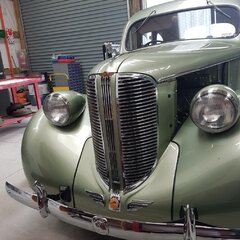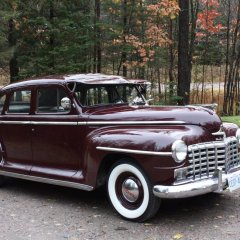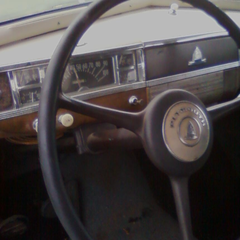-
Posts
723 -
Joined
-
Last visited
-
Days Won
14
Loren last won the day on April 15
Loren had the most liked content!
Reputation
563 ExcellentAbout Loren
- Birthday 10/11/1951
Profile Information
-
Gender
Female
-
Location
Gold Beach, Oregon
-
Interests
All things Internal Combustion
-
My Project Cars
1952 Plymouth Suburban, 1949 Plymouth Business Coupe
Converted
-
Location
Dayton, NV
-
Interests
Antique Cars & Motorcycles
Contact Methods
-
Occupation
Retired
Recent Profile Visitors
The recent visitors block is disabled and is not being shown to other users.
-
The heat shield on my P17 has a hole for a stud or stand off on a dual chamber fuel pump. Not all dual chamber pumps came with the stud/stand off which replaced one of the upper chamber screws. The quick and dirty way to make a substitute would be a piece of “all-thread” rod, 3 nuts and 2 washers. The stud/stand off braces the heat shield over the pump so that it is level. On a single chamber pump the heat shield is allowed to hang however it wants to because there’s chance of contact with the pump.
-
Good ignition and carburetors have been issues since the beginning of the automobile. Charles Kettering gave us the point type ignition back in the 2nd decade of the 20th century. Back in the 1960s we started to get something new the Capacitor Discharge ignition. I had a friend who was tired of his buddies coming around and idly picking things up only to drop them or put them out of the order he had them in. So he get some old electronic capacitors and charged them up then sprinkled his shop with them. Soon it became well known that you shouldn't touch anything in his shop because you could get BIT. The way the Kettering system works is when the points close current builds a magnetic field in the coil and when they open the field collapses and a spark is sent out the secondary winding of the coil. The way the capacitive discharge system works is the circuitry charges a capacitor and the points give the circuitry a signal to discharge the capacitor which sends its charge to the coil which now acts as a step up transformer. The points only act as a signal generator and do not carry the load of the magnetic field, thus they last much longer. So the CD Ignition is really the answer to poor ignition performance. If you have a car converted to 12 volts you could build yourself an HEI set up ( it's not that hard ). But what if you don't want to convert? Well you can try a Pertronix which many have and they are not that happy with them. Or you could go on a treasure hunt and find the best CDI from way back which was the Delta Mark Ten. I went that route because I like treasure hunts and having stuff nobody else has. I even found a guy who can repair them! One of the advances of the "B" model was a switch on the end of the box which switches the unit back to Kettering ignition, but they never made them in 6 volt. So when mine crapped out on me ( corrosion - I live on the coast ) and I didn't have any tools to move the wires back. I determined to find something with a switch. Turns out the son of the inventor has a cottage industry making an advanced 6 volt CDI. He hand builds them to order and they have a three position switch on the top. CDI-OFF-Points. He also makes a 12 volt version. Not cheap but about what Langdon got for his HEI distributor. Fred Winterburn is his name and he's in Canada. If you google Capacitive Discharge Ignition he comes up with a lot of material. So if you have a friend with a syncrograph ( aka distributor tester ) you can get your distributor set super accurate then reinstall it, time it and install Fred Winterburn's ignition box and you are good to good for as long as the rubbing block on the points last. Anyway that's what I have done. And if you really want something unusual go on your treasure hunt for a set of Jet Ignition Spark Plugs. ( aka Jet Flame Injectors ) Really hard to find but worth it. Last made in 1965.
-
These are fun cars! I have one too. The overdrive sure does nothing to hurt the charm of the car. Instead of disc brakes I put Chrysler Windsor 12 inch drums and I am going to add a booster. I am looking for a Special Deluxe club coupe front seat as the P17 doesn’t agree with my back side. The car is so much lighter than the P18s I am seriously thinking of changing the axle ratio to a 3.54 that I have.
-
I have used them and I have recommended them. They have an incredible amount of carburetor data sheets too.
-
Two items worth a question. 1) Does your car have vacuum Wipers? If so get the dual chamber fuel pump and you'll thank me for asking the next time you use the wipers. 2) Does your car have the heat shield over the fuel pump? If so good. You'll find a hole for the stand off in it and the stand off should be on your new fuel pump. If not find one. You'll thank me when your car starts every time when hot.
-
Well all this talk about engine stands is infectious. I got a coupon from Harbor Freight and I had to use it yesterday. So I looked at what they had. They are now using the old Sears "Good, Better, Best" tactic. Years ago I worked for a dealer that had been a Lincoln/Mercury store and in one of their storage areas I found a really nice heavy duty engine stand with a gear crank on it to rotate the engine. I made a couple of adaptors for the stuff I worked on and I was hooked. Years later I had my Snap-On guy order me an OTC version. It was very pricey of course but I still thought it was a labor saver. If you intend on leaving an engine on the stand it's not worth it. If you intend to use it for assembly then it is really worth it. Harbor Freight's "Best" is a copy of the OTC engine stand and I think it is actually better. It has more features and seems to be a little heavier duty. With my coupon it was lots cheaper too. They call it a 1,500 lbs stand but the gear drive is really very nice. When you see three grease fittings on the head and you pull the cover off and see the gears, you know you got a good piece. Next I am going to put together a dedicated mounting plate to mount the engine on the distributor side cross ways. I have worked on inline engines lengthwise and I didn't care for that. A little unstable.
-
A spark? One of the problems I have seen on other cars is the ground wire between the breaker plates is missing. The points have to be grounded ( or is it “positived” on a positive ground vehicle? lol ). The car will run because the current will find a ground if it will start but not always. What usually happens is a progressive decline in ignition performance. Each time the points open there’s a spark. The points are made to last a long time with these sparks but the breaker plate is mild steel and it erodes a little each time a spark is made. I have seen breaker plates so eroded that when the car reaches cruise speed the vacuum advance pulls on the breaker plate and the ground is broken causing a miss until the vacuum advance returns to it’s former position. So I’d pop the distributor cap and look for the ground wire for starters.
-
I can tell you with 100% certainty that old tires can explode. Michelin says tires need to be replaced after 6 years whether they are worn out or not, everybody else says 7 to 10 years. Since the ones I have had explode have all been Michelins, I can verify they know their product! The others just leak or never fill. If you have a car sitting on a flat, try jacking it up before you put air in the tire. Some times they will take air and you can move the car. In a recent move I ended up scrapping over 120 tires that would not hold air, so I think I can speak with some authority. A Bubble on the side of a tire is from damage, like hitting a curb. One of the most injury producing Michelin explosions I had was a tire I took off a car and put on my tire machine. Locked on to the machine I started putting air into it. It got up to 27 psi ( going for 30 ) and 3 inch long gash in the sidewall opened up with a BANG! I was wearing a floppy hat with a chin strap, the blast hit me in the face, blew the hat inside out and strangled me with the chin strap. Luckily I was wearing eye protection and I got a nice bruise where it fit on my face! I felt like I had been hit in the face with a shovel and it took three days for my jaw to get back to normal. Needless to say my ears were not happy at all! After that when I encounter an old flat Michelin, I jack the car up attach an air chuck ( one that stays on ) and apply air from a safe distance. They still blow up but I don't put myself in the line of fire.
-
Years ago when I got out of college my first job was with the Black & Decker Industrial and Construction division. ( 1974 ) They were the world's largest portable electric tool company. After considerable mismanagement they merged with Stanley. I have to tell you the outfit that's selling the stuff I buy these days is Milwaukee. They used to be the tools plumbers used. They make some really outstanding cordless tools that impress me. I have their 1/2 inch M18 cordless impact wrench and it works! A guy I know says Home Depot's Rigid Brand ( another plumber's tool company in the old days ) are warranted for life. When the battery craps out you call them and they send you a new one. They don't even want the old one back. Not sure about all that but that's what he said. Milwaukee even makes hand tools now. A recent purchase was a really nice 1/4 drive set. The sockets have 4 wrench flats! The case has a removable tray so you can put the set in your tool box. The sockets have the size written on two sides in a way you can actually see. Very thoughtful stuff.
-
In an earlier post on this I mentioned that the amount of blow by past the piston rings can exceed how much the vacuum can draw out of the crankcase. It has to go somewhere and that somewhere is either the breather cap on the oil filler or in the second type it goes to the air cleaner and gets sent into the intake stream. Thus while the vacuum side is all one way, the breather side can be two way. That is why the closed system is the only type now allowed under emissions regulations.
-
There are two types of PVC systems and they relate to whether the breather is open to the atmosphere or it is a closed system. The regular filler cap has a mesh screen to keep the bugs out of your crankcase, but it will allow vapor to pass both directions in or out. A closed system uses a sealed cap which has a hose to the air cleaner. Any vapor going into the crankcase passes thru the air cleaner first. Any vapor which comes out of the crankcase will be captured in the air flow going into the intake and thus burned. Whenever you place a vacuum on something it pulls the water vapor out. Water vapor ( along with acid ) is a product of combustion and the source of sludge in the crankcase, so a PVC system is a real good thing. It’s not just emissions, it makes engines last longer. PVC valves serve to prevent intake backfires from causing oil leaks. There are systems which do not use them. They depend on long small diameter rubber hoses and a fixed orifice to prevent excess pressure in the crankcase. I have also repaired blown seals and pan gaskets on these engines. Not many but it happens.
-
200 degrees is not overheating, especially when the engine is shut down. It is normal for the temperature to rise when the engine is shut down because the coolant isn’t circulating. The cars I used to work on had a temp gauge that was very accurate, where the red indicated 265 degrees and the green was 264 degrees. As long as the needle remained in the green you were okay as per the factory service information. The combination of 50% anti-freeze, a 16 lbs radiator cap brought the boiling point up to 265. While the flathead Plymouth has a very minor pressure cap ( what is it 3 lbs? ) with anti-freeze the boiling point is well above 212. Also there should be air space in the top of the radiator, so if you fill it full the excess will leak out the overflow. When it stops leaking, that is the level it should be filled to. Scientific huh? That said, we should remember once the temp gauge bulb is uncovered by coolant, the gauge will read low.
-
The literature says there’s a 2.3 x pressure increase. The cars I’ve driven have great pedal feel and modulation. As I recall someone said it’s a Midland design. The car I am going to put it on is a 49 3 passenger business coupe. It has 12 inch Chrysler Windsor brakes on the front ( now ) and I am going to put the rears on when I do the booster. My feeling is you don’t get the full potential without the booster.
-
From the photo shown, I have a question. Is the other end on the road draft tube plugged? Positive Crankcase Ventilation if not done right is just a vacuum leak. Vintage Power Wagons sells a kit you might want to examine. Also there are instructions ( Service Informations ) in the down load section of this site. I believe they are the most down loaded item. The PCV valve's function is to block the pressure from an intake backfire from the crankcase, so whatever you use you have to make sure it's pointed in the right direction. Otherwise you end up with oil leaks from places you didn't know could possibly leak. Not to get too into the weeds, but there are two types of PCV systems. One uses the Oil Filler as a breather, where air can enter the crankcase ( or exit if there's too much blow by ) The other is a closed system which has a tube running from the Oil Filler to the air cleaner, thus anything that comes out of the crankcase gets burnt. Generally because the Blow By gases have products of combustion and unburned fuel in them, the engine sees what gets sucked in as fuel. So it doesn't need any radical air/fuel adjustments when you add a PCV system. As I said done right and a PCV system is a very good thing. It removes the water vapor which creates sludge. Most race cars have PCV now days.
-
I would draw your attention to a thread titled "Improving Plymouth Brakes" You might consider adding a brake booster to your brake system. I received the remote booster I ordered from Walmart ( yes that Walmart ) for $63. I have to tell you it's a real value and a lot less work than installing disc brakes. Some Chrysler models had a very similar remote booster mounted behind the Master Cylinder so it's not a new idea. The one I got is a Taiwanese copy of an American design, VH44. As is noted in the thread disc brakes require more pedal pressure than drums so you might end up adding a booster anyway to get their full potential. $63, how can you possibly go wrong?








